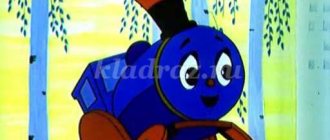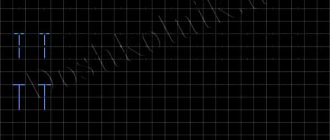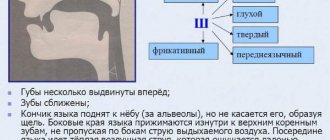If the baby has already learned to correctly pronounce the sound Ш, then you should not force him to immediately pronounce what he heard in words and sentences. Such work should take place under the guidance of a specialist - a speech therapist and includes several stages.
The following steps are being taken in this direction:
- automation of the isolated sound Ш is being worked out through repeated repetition;
- the baby tries to pronounce this sound in syllables and words;
- the sound Ш is introduced by the teacher into phrases and phrases;
- the little student pronounces it in sentences, learns to distinguish words with it in the speech of other people.
Producing the sound Shch in children
Correct pronunciation can be achieved in several ways. In the first case, the teacher starts from the sound Sh that is already familiar to the baby.
In this case, the speech therapist together with the child performs the following actions.
- He asks the fidget to raise the tip of his tongue to the upper alveoli and “hiss like a big snake.”
- The specialist draws the baby’s attention to the fact that his wide tongue in the middle part puts strong pressure on the palate, and its lateral edges are tightly pressed against the upper teeth.
- The frenulum in the oral cavity is tense, and the lips are rounded and slightly pushed forward. The teeth are slightly closed. In this position, when exhaling, the air passes into a narrow gap in the middle of the tongue. And the sound Ш smoothly turns into Ш.
The second method of production includes work that is based on the sound Ch and the syllables Si - As already existing in the child’s speech.
In this case, the work occurs in the following sequence.
- The speech therapist asks the fidget to pronounce the sound Ch for a very long time and then interrupt the exhalation.
- When a child sounds the syllables Si - As, the specialist slightly lifts the tip of a small tongue with a spatula to the alveoli of the upper teeth and gently pushes it back. As a result, the sound Shch is formed.
Automating the sound u in syllables does not present any particular difficulties for children.
I suggest the following exercises.
The sound Ш at the beginning of a word
When a child learns to pronounce a sound in isolation, he begins to repeat after the adult the syllables: Shcha, Shchu, Shche, Shche, Shchi. The automatic repetition of syllables gradually develops into words: “Shcha – Shcha – Sorrel”, “Schu – Shchu – Feel” and the like.
Games and exercises.
- Sort correctly
Multi-colored buttons of different sizes are mixed in a large container. In front of the baby there are small, medium and large plates. During the game, he is asked to put small buttons in small plates and pronounce the syllables Shche and Shche. Place medium-sized buttons in medium plates (syllable Shchu), and fill large containers with large buttons (syllable Shcha).
- I'm looking (using a sound table with the sound Ш).
The teacher offers the child pictures depicting objects, animals, fish. He says the word and asks the kid to put a chip on the corresponding picture. At the same time, he needs to carefully repeat the words: “I am looking” with emphasis on the sound. ("I'm Looking for the Brush")
The sound Ш in the middle of a word
Games and exercises.
- Be careful
The presenter names the words, and the little student claps only when he hears a word with the sound Shch. In this game you can use the following words: thicket, bast shoe, house, mouse, monster.
- Where is “ch” and where is “sch”
The game is similar to the previous one. Only in this case, if the child hears the sound Ш, he claps once. When the teacher pronounces the sound Ch, the child claps his hands twice. The teacher names the following words: repair, general, bathhouse attendant, very, dream, calculation.
The sound Ш at the end of a word
Games and exercises
- Building a house for the sound Shch
For this game you can take a construction set. The fidget is asked to put two bricks - this is the syllable Shcha. After this, add a third to the two bricks - the syllable Shchi. The fourth brick will represent Shu. And when the house of five bricks is ready, the word “ivy” will appear. You can also simultaneously invite the fidget to draw this house on paper.
- Fun buttons
The child must pronounce the word with an automated sound and at the same time press the “button” (drawn colored circle, flower, fish) with his finger. How many such “buttons” there are, so many repetitions there will be.
Words used: help, thing, cartilage, pimple and others.
Corrective work on sound [u] outline plan for speech therapy on the topic
Sound articulation [Ш]
Features of articulation
The lips are slightly pushed forward and rounded. The tip of the tongue is raised to the cusps behind the upper teeth. The lateral edges of the tongue are pressed tightly against the upper molars. The back of the tongue is raised. The tongue is tense. The vocal cords are resting, the throat is not trembling (no voice).
Characteristic
The sound [Ш] is consonant, dull, always soft. The sound is indicated in green.
Preparatory exercises for sound production [Ш]
You can start making the sound [Ш] if the child pronounces the sound [Ш] correctly. First you need to try sound production by imitation (see). If imitation exercises do not produce an effect, you must proceed to the exercises given below. The sound [Ш] is pronounced in the same way as the sound [Ш], only more elongated and tense due to the strong pressure of the tongue on the palate.
Preparatory exercises
- Open your mouth. Suck your entire tongue to the roof of your mouth so that the frenulum is stretched. The tip of the tongue is raised to the front of the palate (at the alveoli). The child performs this exercise by placing his finger (spatula, teaspoon) under his tongue in a horizontal position. The finger should press the tongue to the palate in the middle part.
Having drawn in air, exhale it forcefully, pronouncing a long sound [Ш]. The sound [Ш] will be heard. In this case, the tongue should spring back. The elasticity of the tongue and the gap are adjusted by finger pressure.
It is necessary to achieve a long sound.
- Pronounce a sound without using a finger. If this exercise does not work, it is allowed to pronounce syllables and words with a finger.
The sound [Ш] is colored green (soft consonant sound). Vowel sounds are colored red.
The sound [Ш_] is pronounced for a long time (see articulation of the sound [Ш]).
If this does not work, it is allowed to pronounce sounds, syllables and words with a finger (the finger should press the tongue to the palate in the middle part).
1) Pronounce (read) syllables with the sound [Ш']
Sample: sch__a, sch__o, sch__e sch__u, sch__i, sch__e
2) Pronounce (read) words with the sound [Ш'] at the beginning
Sample: sh__u-ka
If words are pronounced with a finger placed under the tongue, then on syllables without the sound u the finger is removed. After the pronunciation is fixed, the words are pronounced without placing a finger.
|
|
|
|
|
3) Pronounce (read) words with the sound [Ш'] in the middle
Sample: things, area
|
|
|
|
|
4) Pronounce (read) syllables with the sound [Ш']
Sample: esch__, esch__, esch__, esch__, esch__, esch__, esch__, esch__, box__
5) Pronounce (read) words with the sound [Ш'] at the end
Sample: thing__, to-va-pish__
|
|
|
|
6) Pronounce (read) phrases
Sample: That thing
- Running puppy.
- Boiling cauldron.
- Growing vegetables.
- Singing goldfinch.
- I'm rinsing my coat.
- Melting ice.
- I'm looking for pliers.
- Help from a friend.
- Small gap.
- Box of things.
- Plank floor.
- I'm carrying a box.
- The waves are shining.
- Climbing ivy.
- Large bream.
7) Conjugate sentences
- I'm looking for a brush.
- I'm looking for wood chips.
- I'm carrying things.
- I walk across the square.
- I grow vegetables and sorrel.
Sample:
- I'm looking for a box.
- You're looking for a box.
- He (she) is looking for a box.
- We're looking for a box.
- You are looking for a box.
- They are looking for a box.
 Say (read) sentences
Say (read) sentences
Sample: Vova caught a le-sch__a. Sh__i is cooked from vegetables___
- Children are looking for mushrooms.
- Petya put on his cloak.
- The puppy was given cartilage.
- A friend came to Vanya’s aid.
- The moon illuminates the grove.
- There are bream in the lake.
- Treat your friend.
- There are goldfinches in the grove.
- A puppy is squeaking in the yard.
- Wolves prowl, looking for food.
- In the grove, a stork flaps its wings.
- My shuttle has disappeared; my puppy stole it.
- The stars sparkle in the blue sky, the waves splash in the blue sea.
- Listen up, buddy! You, they say, are a great master of singing!
9) Pronounce (read) pure sayings
- Wolves prowl - looking for food.
- Tongs and pliers - these are our things.
- There are more thickets in our Pushcha. In our forest the thicket is thicker.
- The puppy squeaks pitifully, he drags a heavy shield.
- Bring vegetables and there will be cabbage soup.
- You won't find pike or bream in the grove.
- I clean the puppy with a brush, tickling its sides.
- The pike swims around the bream, its fins fluttering.
- Two puppies are nipping cheek to cheek at a brush in the corner.
- Yes, the brush has a floor stick above its head.
- Stick click, puppies off your shoulder!
- The two puppies walked away grumbling!
- It's raining, it's raining, it's raining, I'm without a raincoat.
- It's raining, it's raining, and I'm wearing a raincoat.
- I feel, I feel, I feel, I feel, I won’t find you.
- Cabbage soup, cabbage soup, cabbage soup - go and look for me.
- I feel, I feel, I feel, I feel, I feel, I will find it now.
10) Pronounce (read) and retell the text
Goldfinches
Red-cheeked goldfinches flew into the grove. They built a nest and got goldfinches. Vitya climbed up the tree to look at the goldfinches. There were no parent goldfinches. But the goldfinch did not let Vitya near. They didn’t know how to fly yet, so they ran away from Vitya along the branches. Two goldfinches fell. Vitya caught one. The goldfinch squeaks and pinches Vitya’s hand. Vitya planted the trembling goldfinch on a branch. But the goldfinch froze and was nowhere to be seen. The predator will not guess that it is a goldfinch. This is how goldfinches escape.
11) Pronounce (read) and memorize a poem
My puppy
The puppy was so puny. I kept feeding him cabbage soup and protecting him from the bitter cold. The puppy squeaked with joy. Still would! He grew up happy! Now my puppy is not a puppy, but a real dog!
Word combinations and phrases starting with the sound Ш
- Teach Petrushka to speak correctly (finger theater)
The Parsley doll comes to visit the child, who tells her story and depicts the story with appropriate actions. At the same time, the narrator deliberately distorts the sound Ш in phrases and asks the little viewer to correct it.
Stories can be on the topic: “Burning Chips.” "Help to comrades."
- Catch and throw
The adult throws the ball to the baby and pronounces phrases with the given sound, and the child finishes the phrase correctly. In the game, it is advisable to use a phrase such as: “Skinny Pike live in the river.”
Automation of the sound Ш in sentences
Below are examples of sentences that a child repeats after an adult.
Vegetables are stored in a box. A predatory pike caught a bream.
An example of a poem that can be learned and recited by heart.
Kotische built a huge house
And he generously gave it to the mosquito.
A feisty mosquito has settled in the house.
And he bit the poor cat.
Also, the process of automating sound will go much faster if parents and their child reinforce their pronunciation every day at home.
Conclusion. Daily exercises and the gradual introduction of sound into oral conversation will lead to clear and correct speech. Surely the ugly lisp, which so upset both the baby and his parents, will disappear. A stable pronunciation for a child aged 4–7 years can be achieved only if the child is truly carried away by the process and notices the long-awaited result.
Other articles on the site that are worth paying attention to:
“The 4th extra” is a speech therapy game. Automation of sound R
“Greedy” – a speech therapy game to automate the sound “R”
Type of speech - narration
Methods for diagnosing alalia
What exercises are useful for rhinolalic patients?
Related posts:
- The sound “Zh” - from production to automation Automation of the sound “Zh” begins with identifying the reasons that interfere with the correct sound pronunciation...
- Logorhythmic classes and correctional means By various means, speech therapy classes contribute to the effective correction of speech in children...
- A child does not know how to say R - we’ll show you how to teach it. To teach a child to pronounce the letter R, you need to regularly perform special...
- Rhoticism in speech - complete information Rhotacism (problem with the sound [P]) is the most common disorder in children...
What to do if the child does not make hissing sounds
Setting up hissing sounds such as [w], [zh], [sch], [h] is perhaps the most difficult for a speech therapist. And all because the articulatory structure of [w] and [zh] is very complex, but it’s also impossible without sibilants. Speech takes on a whistling tone, and most importantly, the child will make many mistakes in writing. Impaired pronunciation of hissing sounds is called sigmatism of hissing sounds, and it is this that is the cause of most speech therapy errors in writing: “syska” instead of shishka, “zaba” instead of toad, etc. I’ll tell you in more detail how to correct this speech defect.
Causes
First you need to understand how the organs of articulation work when producing the sound [w]. The lips are pulled out into a tube and resemble a house in shape; the rows of upper and lower teeth stand exactly above each other, forming a gap through which a stream of air passes freely through the center of the tongue. The tip of the tongue rises behind the upper teeth, its lateral edges are pressed upward, the tongue located in the oral cavity is shaped like a cup. The problem for many children is that the muscles of the tongue are not strengthened enough, and the tongue, instead of rising to the top, lies at the bottom of the mouth, even if we hold our lips and teeth correctly. A passing stream of air produces the sound [s] instead of [w]. Another problem is that the child, trying to lift his tongue up, exhales air into his rounded lips and pronounces the sound [w], but the air stream does not pass through the gap between the upper and lower teeth, but from the side, forming the sound [f]. Also, often the tongue does not obey and simply falls out of the mouth.
Since the tongue is located in the depths of the mouth with almost closed teeth and lips extended forward, we cannot see whether it is positioned correctly there, which is why it is very difficult to control the articulatory pattern and produce sound.
Types of hissing sigmatism
To choose the right way to set hisses, you first need to determine what type of disorder this particular child has. The main thing for us is to put the sound [w], and it makes it easier to put [zh], [sh] and [h]. Here are the types of this disorder found in nature.
Interdental sigmatism
- a phenomenon when the tip of the tongue protrudes between the lower and upper teeth, creating a cracking sound.
Labiodental
sigmatism - the upper lip, when producing hissing sounds, lifts up high towards the teeth, and the tongue most often lies at the bottom of the oral cavity. Incorrect articulation causes a mixed sound fs or vz when pronouncing [zh].
Whistling sigmatism
– in this situation, the tongue does not rise up, it remains below, as when producing the sound [s], so we hear a whistle instead of the expected sound. In such cases, they also say that the child’s [w] is lower.
Dental sigmatism
– the tip of the tongue rests on the upper teeth, when the sound [w] is formed, a sound similar to [t] is obtained, when [zh] is formed - [d].
Lateral sigmatism
- a phenomenon when the tongue rises unevenly in the oral cavity, but as if with an edge, a stream of exhaled air goes into the cheeks, which noticeably inflate, and instead of the expected [w], we hear [f].
Nasal sigmatism
- in this case, the root of the tongue lifts up excessively, preventing the stream of air from passing through the mouth and goes into the nose.
Articulation gymnastics for hissing sounds
To produce any sound, articulatory gymnastics are simply irreplaceable and extremely necessary. To establish hissing sounds in speech, the same set of exercises is needed for both [w], and [zh], [sch] and [h]. First of all, we need to work on the lips and tongue. It is best to perform the exercises in front of a mirror so that the child visually catches the correct pose, and if something happens, he can correct the incorrect position of the organs of articulation.
| "Smile" - We stretch our lips into a smile. "Tube" - rounded lips stretch forward. "Smile-pipe" - alternation of poses. "House" - the teeth stand evenly on top of each other, close together, the lips are slightly extended forward, resembling a rectangle, the mouth is open. "Spatula" — stick out a wide, flat tongue from the mouth and hold it on the lower lip in a static state for 5 seconds. "Delicious jam" - work on the upper rise of the tongue, lick the upper lip. "Swing" - the tongue smoothly rises behind the upper lip and falls to the lower. "Let's brush our teeth" - slowly raise your tongue and lick the upper row of teeth from the outside and then from the inside. "Horse" - tongue clicking. |
"Sail"
- a good exercise for strengthening the muscles of the tongue, allowing the child to hold the tongue up for a long time. In this case, the mouth is necessarily wide open, the tip of the tongue rises and stands behind the upper teeth, touching the alveoli. So we hold our tongue for a count of ten, gradually increasing it, if possible, to forty.
"Cup"
- with your mouth wide open, stick out your tongue, lift the tip up, and bend the side edges. The tongue resembles the shape of a cup. The exercise is very difficult even for an adult and requires systematic training. To begin, have the child curl the tip of his tongue behind his upper lip, then open his mouth wider, lifting off his upper lip and holding the tip-up position for a few seconds. Having secured this position, we work on lifting the lateral parts of the tongue. This exercise is mandatory for producing hissing sounds, since the tongue must learn to take the shape of a cup in the oral cavity.
Breathing exercises
In addition to gymnastics, when setting hissing ones, exercises are needed to produce an air stream. The exercises are carried out in a fun, playful way, which arouses a keen interest in the child in the activity.
1. We blow on candles, matches, various pinwheels, feathers. 2. The widely spread tongue lies motionless on the lower lip (“Spatula”), we ask the child to blow on the protruding tip, ensuring that the stream of air does not pass from the side, but exactly along it - we try to blow a light foam ball or a wad of cotton wool into the intended gate, sitting in front of the table . 4. “Focus” - place a small piece of cotton wool on the tip of the nose, slightly push the lower lip forward and blow on it, trying to direct the air stream upward. The purpose of the exercise is to blow the cotton wool off your nose.





